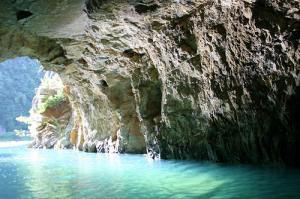Mystical Caves Draw Tourists to Trang An

Vietnam is known to offer fascinating places to visit, both in the highlands of the northern area and the southern beaches. Ninh Binh Province, located 100 kilometers west of ${bigcity_Hanoi:"Hanoi"}, is becoming among the most tempting options because of the growing popularity of the enchanting caves in Trang An.
Because of its system of big limestone mountains, caves and traces of an ancient sea believed to have existed some 200-250 million years ago, Trang An is also called the “the open geological museum.” It also earned the name “inland Ha Long Bay”, referring to the harbor, which was declared twice as a World Heritage Site by UNESCO (in 1994 and 2000) because of its beauty and geological peculiarities. This 12,000-hectare area, which lies between Hoa Lu and Gia Vien districts, attracts many tourists because of its rare biodiversity.
This eco-tourism complex boasts of 48 grottoes and caves, 31 valleys and the hallowed cultural area of Bai Dinh Pagoda. The area is surrounded by mountains of limestone, lakes, and a rich ecosystem with hundreds of different species. More than 200 of these species are in Vietnam’s Red List, like the co soc tortoise (Ocaclia sinensis).
The most famous attraction at Trang An is a network of caves in the limestone mountains that are always submerged. There are about 48 caves in the area, totaling to 20 kilometers in length, and each followed by water areas of wild beauty and unique names. The 31 ponds and lakes situated in between the caves create a somewhat giant labyrinth.
In addition, ancient relics of prehistoric man, from 5,000 to 30,000 years ago, were found in caves such as cave Bui and cave Trong. Historic monuments such as the temples of King Dinh Tien Hoang and King Le Dai Hanh, Dong and Den bridges and traces of the citadel ancient walls remained intact.
Tourists can now take a 5-kilometer boat tour through 12 caves which starts at the Ang Muong boat station. Here, over 300 small boats are anchored. The boat rowers are locals who are trained as tour guides armed with knowledge about the site and caves they can share with visitors. The first stop is the Trinh Temple, built in 1865 and restored in 2003.
Next stop is the Dia Linh (Sacred Earth) Cave. Many of the branches of this cave, which is 1.5 kilometers long, are yet to be explored. The cave’s width is not consistent – at some places it is just some three meters wide. The Toi (Dark) Cave, is the longest cave at 315 meters. Here, visitors have to turn on their flashlights to observe stalactites of various shapes inside. Another recognizable character of the cave is that its temperature is always 2-3 degrees Celsius higher than outside because of a hot stream. In contrast to the Toi Cave, the Sang (Light) Cave receives natural light from both ends as it is just about 100 meters long.
Before reaching the second temple on the route, the Tran Temple, visitors go through the Nau Ruou (Distilling Wine) Cave which hosts a 15-meter deep well. According to legends, the well was used by ancient people to make wine. Archeologists have actually uncovered several vases and jars along with wine-producing devices in the area. Tran temple was built in the 10th century to worship Tran Quy Minh, a general of the pre-historic dynasty ruled by the Hung King. From here, visitors can have a full view of the cave which is located right outside and on a 350-step stone stairway.
Visitors will then be taken to the Sinh, Si, Ba Giot (three drops), Seo, and Son Duong (Chamois) caves. The most appreciated features here are its stalactites that are mostly white or marble blue, and have a glowing quality. These caves are between 100 and 250 meters long.
Leaving the Son Duong Cave, visitors reach Phu Khong, a temple dedicated to another official of the Dinh Dynasty. It is located on a narrow strip of land next to the 60-meter Khong Cave. Visitors who come by never miss to take pictures of the gold apple (Diospyros decandra) tree believed to be 1,000 years old. It grows on a rock and its roots covering an area of some 10 square meters. One mysterious character of the tree is that its fruits are always in two different shapes: round with seeds, and kind of flat without seeds. Tran and Quy Hau caves, 200 and 100 meters long respectively, are the last destinations of the tour.
Drifting on the rivers, discovering the mysteries of the caves and breathing the incense smoke from the temples leave space for peace in the soul. Trang An is truly a land of myth and fantasy – truly a captivating destination for any visitor seeking for beauty and mystery.









